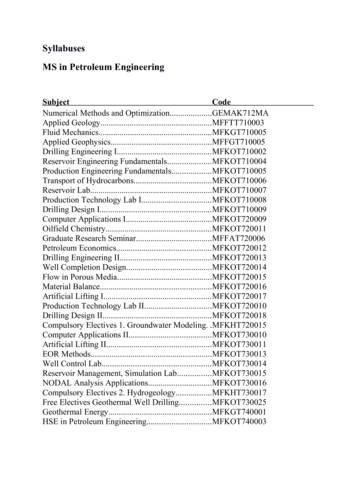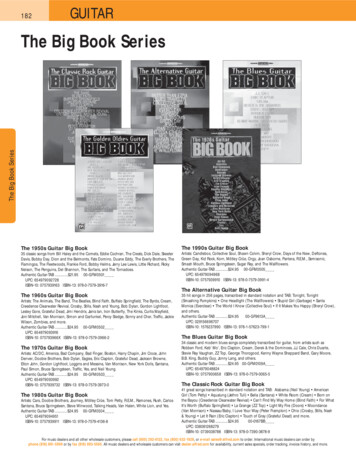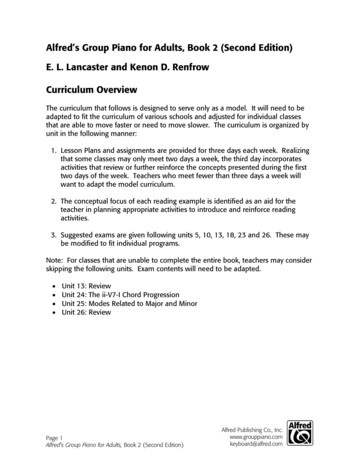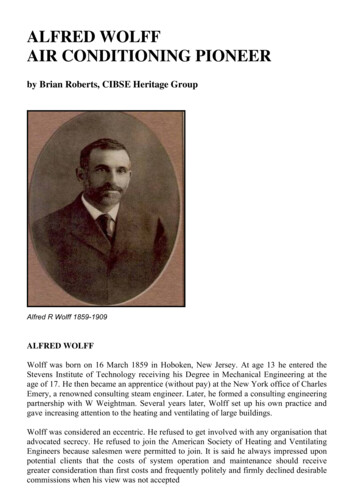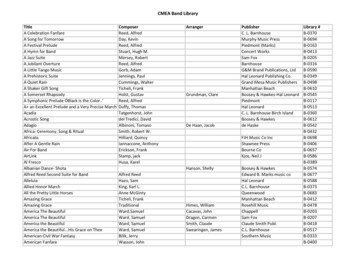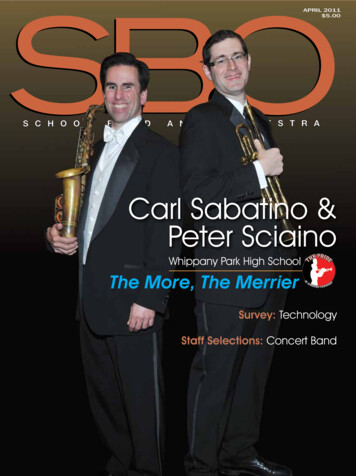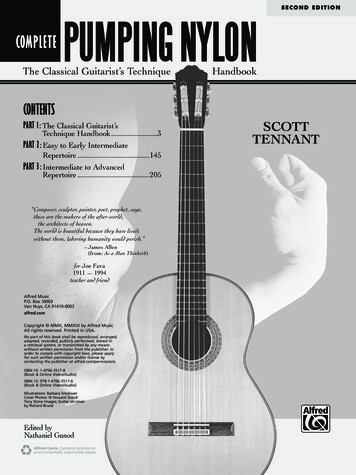
Transcription
SECOND EDITIONCOMPLETEPUMPING NYLONThe Classical Guitarist’s TechniqueHandbookCONTENTSPART 1 : The Classical Guitarist’sTechnique Handbook .3PART 2 : Easy to Early IntermediateRepertoire . 145PART 3 : Intermediate to AdvancedRepertoire . 205“Composer, sculptor, painter, poet, prophet, sage,these are the makers of the after-world,the architects of heaven.The world is beautiful because they have lived;without them, laboring humanity would perish.”– James Allen(from: As a Man Thinketh)for Joe Fava1911 — 1994teacher and friendAlfred MusicP.O. Box 10003Van Nuys, CA 91410-0003alfred.comCopyright MMX, MMXVI by Alfred MusicAll rights reserved. Printed in USA.No part of this book shall be reproduced, arranged,adapted, recorded, publicly performed, stored ina retrieval system, or transmitted by any meanswithout written permission from the publisher. Inorder to comply with copyright laws, please applyfor such written permission and/or license bycontacting the publisher at alfred.com/permissions.ISBN-10: 1-4706-3517-8(Book & Online Video/Audio)ISBN-13: 978-1-4706-3517-6(Book & Online Video/Audio)IIllustrations: Barbara SmoloverCover Photos: Howard Sokol/Tony Stone Images; Guitar on coverby Richard BrunéEdited byNathaniel GunodSCOTTTENNANT
SECOND EDITIONCOMPLETEPUMPING NYLONPART 1The Classical Guitarist’sTechnique Handbook
4CONTENTSAuthor’s Preface .6Editor’s Preface .7Some Do’s and Don’ts .8About the Hands .8About the Body.9About Holding the Guitar—The Triangle .10Footstool Alternatives .10The Right Hand .58Tone Production .58Nail Length and Shape .58Nail Length .59Nail Types .59Shaping the Nails .62Angle and Placement .62Rest Stroke (Apoyando) .63Position .63The Left Hand .12The Movement .63Finger Placement and Accuracy .12Planting .63Pressure and Release .13Pressure .64Pressure/Release Exercise .13Release .64Finger Exchange .13Free Stroke (Tirando) .64Ascending Slurs (Hammer-ons) .15Right-Hand Finger Independence .65Descending Slurs (Pull-offs) .16Walking .65Finger Independence.17Variations.65#1 .17#2 .18Arpeggios from Tarrega’s The CompleteTechnical Studies .66#3 - Opposing Motion .19The Thumb .68#4 - Horizontal Character Builders.20Shaping the Nail .68#5 - Odair’s Favorite Drill .23Develop That Thumb! .69#6 - “The Spider” .24Balance in Chords .70The Barre .24Balancing Act.70Weight vs. Pressure .24Being Selective .25Summing It All Up .25Quadrivial Quandary by Andrew York—A Four-Voice Study for the Left Hand.26Fanfare—A Slur Study by Brian Head .28May the Notes Be with You—A SlurStudy by Evan Hirschelman .31Flamenco Techniques .72What Else Can the Thumb Do? .72Soleares Falseta.72Alzapua .73Alzapua Falseta .73Rasgueados .74Some Practical Applications .761st Movement .32from Turina’s “Sevillana” .762nd Movement .36from Turina’s “Ráfaga” .76Giuliani’s Left-Hand Etudes, Op. 1.41from Rodrigo’s “Concerto de Aranjuez,2nd Movement” .77
5Daily Warm-Up Routine .78Scales: Contol and Velocity .94Left-Hand Walking—#1, #2, & #3 .78Misconceptions About Speed .94#1 .78Right-Hand Velocity .94#2 .79Synchronization .97#3 .79String Crossing .98Ascending Slurs—#4 .80Piecing Things Together .98#4 .80Some Other Speed Aids .100Descending Slurs—#5.81Rhythmic Variations .100#5 .81Problem Solving in Scales .103Triplets—#6 .81Marking String Crossings .103#6 .81Evolution of a Scale .104Fixed-Finger Exercises—#7 & #8 .82Scale Study—Double from the Courante,Partita No.1, BWV 1002,Johann Sebasatian Bach .106#7 .82#8 .83Right-Hand Walking—#9 .84Arpeggios .110#9 .84Full Planting and Sequential Planting.110Two-Finger Rasgueados—#10 .84Giuliani’s 120 Right-Hand Studies .111#10 .84Practicing Tips .111Tremolo .86Shapeshifting—An Arpeggio Etudeby Evan Hirschelman .130Psychological Outlook .86Exercises .86Exercises 1–3.86Exercise 4 .87Exercises 5–10.88Exercise 11 .88Lopsided Tremolos .89Chant by Brian Head—A Tremolo Study .89“Chant” Preparation.89Chant .92Shapeshifting—2nd Movement .131Didactic Doodle by Andrew York .139Afterword .142Performance Anxiety.142A Simple Deep Breathing Routine .143Practice .143Inspiration .144In Conclusion.144
9In the two diagrams that follow, notice how the same principle applies to the left hand.The straighter the wrist, the moredexterity your fingers will have.Bending your wrist too much makesit a struggle to play.As for your left-hand thumb, it’s generallywise to keep it positioned just underyour second (middle) finger. This createssomewhat of a vise, and allows for an evendistribution of pressure throughout the hand.About the BodyThe body should also be in a relaxed state. While seated, try stretching your neck and spine upwardstowards the ceiling, pulling your shoulders back slightly (just enough to keep them from drooping forward).Now, relax your muscles so that your body sort of freezes itself in that position. This is a good state forthe body to settle into. Your shoulders should not crunch upward into your neck. Take a look at theillustrations in the following section about holding the guitar.
18#2Now we will deal with moving two fingers and fixing two fingers. The same principles apply here: rootingthe two fixed fingers through to the back of the neck, while keeping the two movable fingers as lightas possible. You’ll find there’s more potential for strain here, so take it slow and focus on the stretch asyou extend your fingers, and then on the opposing motion as they pass each other. Finally, sustain thesecond bass-note as your next finger travels up to the treble, and then hold the second treble-note as youswitch to the bass, etc.&Fix on 3 :bœœ4344 . 2b œ5 1œœ2 1œ2b3œ2 2œbœ44 .3œ25 #œ1& œbœ44 .4œ 3 œ5& œœ44 . 24 œ bœ42& #œœ44 .4œ1œ54& #œ#œ& œ412312344 .4 3œ 1œ5œ2 # 3œ4œ2 2œœ2 1œ# 3œ2 1œœ œœ œœ œœ œœ œœ œœ œœ œœ œœ œœ œœ œb2œ6 1 œb 2œ 1 œ1œ1 # 2œœ œ33œ6 2 # œœ 3œ1œ œ44œ6 3 œœ b2œ1œ œ44œ6 b2œœ 1œ1œ œ44œ6 1 œœ1 1œœ œ33œ6 1 œœ œœ œœ œœ œœ œœ œœ œ.
62Shaping the NailsAlways use a file, as opposed to a nail cutter, to shape the fingernails of your right hand. Nail cuttersleave the fibers of your nails with jagged ends, even if you polish with sandpaper afterwards.Always file your nails with your fingertips facing you. Position thefile underneath the nail at a slight angle and look down the surface ofthe file. This gives you the ideal view of the edge of the nail. Try tocreate a straight line as seen from this angle, as illustrated on the right.Ideally, the file will touch the edge of the nail evenly across its width,and fit securely underneath it without rocking around. If the shapeof your nail is too round, you will notice a rocking motion as the filemoves around the nail’s edge.The line illustrated to the right will only be seen from this particularangle. The nail shape is not actually straight or flat. It will still appearrounded, although possibly not as round as the fleshy fingertip.These ideas for shaping your nails are only suggestions. There are many variations on the four nail typesdiscussed in this book. While I have found that the corresponding shapes suggested here work wellconsistently, experimentation is encouraged. Find out what works and feels best for you.Angle and PlacementIn order to achieve a full, or “fat” tone, we must give special attention to the angle of the fingertips to thestrings. Note that when the fingers are initially placed on the strings, only the flesh makes contact. Thenail makes its contact when pressure is applied. The illustration below shows an advantageous angle.When a finger moves straight back into thepalm from this angle, it is actually movingover a healthy portion of the string surface(as the string uses the nail as a “ramp”) whichenhances the tone. This angle, however,creates a scraping sound on the wound bassstrings, and should therefore be adjusted toa straighter angle for playing on the fourth,fifth and sixth strings.
66Arpeggios from Tarrega’sThe Complete Technical StudiesThese are great exercises for developing your finger independence. They involve standard fingercombinations in the context of awkward string crossings.Practice using free stroke, with a full sound. Wherever string crossing is involved, make sure you preparethe next note immediately after releasing the last.If you are one of the multitude of players who have difficulty playing a thumb rest stroke while doingfree strokes with your fingers, this is a good opportunity to work on that technique.Take your time. It is best to work on a few of these during a practice session, and become comfortablewith them before moving on. You don’t necessarily have to play them all every day.& 44 œ œ œ œ œ œ œ œ 1.imimmimi& œ œ œ œœ œ œ œ 5.i m i3m i mma2.6.mimimœœœœœœœœ imiœ œ œ œœ œ œ œ m i m i m i3.7.aa m a mœœœœœœœœ mamœ œ œ œœ œ œ œ m a m a m a4.8.m a m aœœœœœœœœ mamaœ œ œ œœœ œ œ a m a m a m& œ œ œ œ œ œ œ œ œ œ œ œ œ œ œ œ œ œ œ œ œ œ œ œ œ œ œ œ œ œ œ œ œ œ œ œ œ œ œ œ œ œ œ œ œ œœ œœ œ œ œœ œ œ œœ œ œ œœ œ œ œ9.im& œ œ œ œœ œ œ œ 13.10.14.mimaœ œ œ œœ œ œ œ 11.15.mamiœ œ œ œœ œ œ œ 12.16.amimœ œ œ œœœ œ œ
131## ### ##&&## ##&&&& ### ### ##&&4 & ##4 & ##4 & #4 &44## ### ##&&7 & ##7 & ##7 & #7 &77## ### ##&&10& # #10& # #10& #10&1010## ### ##&&12& # #12& # #12& #12&1212## #&& ## ##14& # #14& # #14& #14&14ShapeshiftingII.œœVibrateœœ œ œœ œ œœ œ œœ œ œœ œ œœ œ œœœœ œ œ œœ œ œ œœ œ œ œœ œœœLetœœ* œ œ œ œ œœœLetœ Vibrateœœœœ œœœ œœœ œœœ œœœ œœœ œœœ œœœ œœœ œœœ œœœ œœœ œœœ œœœ œœœ œœœ œœ œœœ œœœœ œœœ œœœ œœœ œœœœ œœœ œ œœœ œœœœ œœœ œœœ œœœ œœœœ œœœœœ œœ œœ œœ œœ œœ œœ œœ œœ œœ œœ œœppœœ œœ œœ œœ œœ œœ œœ œœ PœœœœPppPœPppPP 80 - 88 80 - 88 Let80 -Vibrate88 Let80 -Vibrate88im Let80 -Vibrate88i m-Vibrate Let80884444444iiii000000mmmm2222221p1p1p1p1p1pœœ œœœœ œœ œœ œœ œœœœ œœ œœ œœœœ œœ œœ œœ œœœœ œœœœ œœ œ œœ œœŒ œœ œ œœ œ œœ œ œœ œœ œœ œ œœœœ œœ œ œœ œœŒŒ œœ œ œœ œœ œœ œ œœ œœ œœ œ œœŒŒœœœœŒœœœ œœ œœ œœ œœ œœ œœ œœ œœ œœ œœœœ œœ œœ œœ œœ œœ œœ œœ œœ œœ œœ œœ œœœœ œœ œœ œœ œœ œœ œœ œœ œœ œœ œœ œœ œœŒŒŒ œœ œœ œœœœœœœœŒ œœœœŒŒ œœœœœœBIIBIIiBIIiBIIiBIIiBIIi1i111 111p 11p1p1p1ppmmm2m2m2m222mmmmmm6a6a64 a64 a64 a64 a44iiiiii666666iiiiiimmmmmmTrack 8iiiiii333333111111œœ œœœœ œœ œœ œœ œœœœ œœ œœ œœœœ œœ œœ œœ œœœœ œœœ œœ œœœ œœ œœœ œœ œœœ œœ œœœ œœ œœœ œœŒŒ œœœ œœ œœœœœ œ œ œœ œ œ œœ œ œ œœŒŒ œ œœ œœœŒŒ œœœœ666666œœ œœ œœ œœ œœ œœ œœ œœ œœ œœ œœ œœœ œœœœœ œœœ œœœ œœœ œœœœŒŒ œœœ œœœ œœœ œ œœœ œœœ œœœ œœœœ œœœ œœœ œœœœœ œ œ œœŒŒ œ œ œœ œ œ œœ œ œœœŒŒœœœ666666œœ œœœ œœœ œ œ œœ œœœœ.œœœœ. œ œœœ œœœ œœœ œœœ œœœ œœœŒ œœœ œœœ œœœ œœœ œœœ œœœ œœœ œœœ œœœ œœœ œœœ œœœ œœœ œœœ œœœ œœœ. œœ œœ œœ œœ œœ œŒ œœ œœ œœ œœ œœ œœ œœ œœ œœ œ œœ œœ œœ œœœ œœŒŒ œœ œœ œœœ œœ œ. œœ œŒœœœŒwarm and forcefulwarm mand forcefuli and forcefulwarmi mwarmand forcefula m ii mwarmand forcefula m ii mwarmandforcefula m mœœiiœœiœœaaaaaaœœœœœœœœœ œ œœp œœœ œœœ pœœ œœœœpp œœ œœ ppœœpœ œp œpœ œpœppp œpœp œp œpœppp œœaaaaaaœœ œ œ œœœ œœœœ œœ œœ œœ œœœœ œœEvanœœ Hirschelmanœœ œœ œœ œœ œœœœœœœœœœœ œœ œœ œœ œ œœ œœ œœ œ œœ œœ œœ œœŒŒŒ œœ œœ œœœœ œ œ œœ œ œ œœ œ œ œœŒŒ œ œœ œœœŒ œœœœ**iiiiiiœœœœœœ666666œœ 000œœ œœ œœ œœ œœ œœ œœ œœ œœ œœ œœœ œœœœœ œœœ 000œœœ œœœ œœœœ œœœ œœœ œœœ œ œœœ œœœ œœœ œœœœ œœœ œœœ œœœœœ œ œ œœ œ œ œœ œ œ œœ œ œœœFœœFœFFFFœœ œœ œœ œœ œœ œœ œœ œœ œœ œœ œœœœ œœ œœ œœ œœ œœ œœ œœ œœ œœ œœ œœ œœœœ œœ œœ œœ œœ œœ œœ œœ œœ œœ œœ œœ œœŒŒŒ œœ œœ œœœœœœœœŒ œœœœŒŒ œœœœœœ222222666666666666ii m 6 ii mœœœim6 i mœœœmm6œœœœœœœiœœœm.0 œ œ œi œm6œœœœœi0œ œ œ œ œ œ œ œ œ œ œœ00œ œœ œœ œœ œœ œœ œœ œœ œœ œœ œœ œ œœœ œœœ œœœ œœœ œœœ œœœŒ œœœi œœmœ 6œ œœœi œœœm .œœ 00œœ œ œ œœ œ œœ œ œ œœ00 œ œœ œ œ œœ œŒŒ œœ œ œ œœ œ .œ ppœœŒŒ œ pœœœ œ .œ œœ œœ00 œœœ œœœœ œœœœmmmmmmœœœœœœiiiiiimmmmmmiiiiiinotes should not ring through each other. In addtion, 5th stringp melody notes that arefollowed by a rest are dampened by lifting or using the backside of thumb.** With this rest, the composer is emphasizing that the previous bass note should be stopped. 2015 Dream Design Music �œœ œœœ œ œ œœœpp œœœœœ pœœ œœ œœpp œœpœ œ ppœ œ ppœ œppi mi m œœœ œœ œœœ œœ œœi m œœmœœœœœœœœœiœœœœ ppœœœ œœœ œœœ œœp œœœ œœœ œœœ œ œœp œœœii œœœmm œœœ œœœ œœœ œ œ œœœ œœœ œœœ œœœ œœœœ œ œp œœp œ œ œ œ œ œ œœ œ œœ œ œpœ œ œ œœœ pont.ppiùpœ œœœ œœp œpp œ œ œ œ ppœœ œ œppiùpœœ pont.œœpppiùpont.œœp14œœppp œpp melody notes (stemsppœœdown).più pont.ppiù pont.* Let all notesvibrate,except5th&6thstringThese melodyppiù pont.piiiiiiœœœœœœœœœœœœi mm6œœœœœœp aa mpmpa ma ma ma mœœœœœœœœœœœœiiiiiiœœœœ œœœœ ppœœpœpœpp(no rit.)(norit.)mi rit.)(nom ai rit.)(nom ai rit.)(nom ai(norit.)i m aœœœœœœpp œœi œœœmœœ œœœpp tastopiùpiùœœp tastopiùtastop tastopiùpiù tastopiù tastoœœœœœaaœ
SECOND EDITIONCOMPLETEPUMPING NYLONPART 2Easy to EarlyIntermediate RepertoireAudio tracks recorded at Penguin Studios, Pasadena, CA; masteredat Bar None Studio, Northford, CT
146CONTENTSThis table of contents is designed to help you use this section as effectively as possible. Not only will itgive you an “at-a-glance” tour of what the section contains and help you find the specific piece you seek,but it will also help you find pieces that relate to the specific areas of technique you wish to study. Thepieces appear in order of difficulty. The categories of technique are shown across the top. The boxeschecked next to a piece tell you which technique(s) apply to that piece. The technique categories aretaken directly from the first section of this book. — Nathaniel Gunod147.Preface148.Glossary of Signs and Terms149.Different Strokes (Tennant/Gunod) .150.Walking (Tennant/Gunod) .152.Opus 44, #6 (Fernando Sor) .153.Bit o’ Nostalgia (Scott Tennant) .154.Snowflight (Andrew York) .156.Crispin’s Spin (Omid Zoufonoun) .157.Estudio #2 (Francisco Tarrega).158.Etude #19 (Matteo Carcassi) .160.Opus 35, #18 (Fernando Sor) .161.Sore Study (Fernando Sor/Scott Tennant) .162.Opus 60, #18 (Fernando Sor) .164.Opus 60, #24 (Fernando Sor) .166.Malagueña (arr. Scott Tennant) .168.Etude #13 (Matteo Carcassi) .170.Etude #7 (Matteo Carcassi) .172.Little Ländler (Sköt Tennant) .174.Etude #2 (Matteo Carcassi) .176.Two Studies (Francisco Tarrega)176. Estudio #12 .177. Estudio #3 .178.Etude #6 (Matteo Carcassi) .180.Etude #12 (Matteo Carcassi) .182.Opus 6, Studio 4 (Fernando Sor) .184.Opus 35, #19 (Fernando Sor) .185.Studio de Campanelas su unTema della “Folia”di M. de Fossa (Francisco Tarrega) .186.3 Pavans (Luis Milan)186.Pavan #1 .187. Pavan #2 .188. Pavan #3 .189.Opus 44, #8 (Fernando Sor) .190.Opus 35, #5 (Fernando Sor) .192.Slur Study (Mauro Giuliani).194.Opus 31, Leçon XV (Fernando Sor) .196.Opus 31, Leçon XII (Fernando Sor) .200.A Pale View (David Pritchard) .203.Afterwordcerslu denSnginpend ndegecinrIeskeglD ngainWndnc sts bFiadagalur umndanoslo d B d Bgi ndin Ha ting t-H sogTherpe sce eft- lan igh calem ho pee herrSCALAPTTR S
154SNOWFLIGHTAndrew YorkTrack 14A lovely, easy, arpeggio piece, this is one of 8 Discernments by York.CHECKLIST: Be very attentive to tone production. Take this opportunity to feel the independence of each right-hand finger. Don’t move your left hand off of any chord before the right hand finishes the arpeggio. Follow the indicated dynamics. . 80–108# 12 œ œ œ œ œ œ œ œ œ œ œ œ œ œ œ œ œ œ œ œ œ œ& 8 œ œ œ œ œœ œœ œœ œœ œœ œœ œ œ œ œ œ œ œ œ.P mysterious, dream-likei m03pi mi mi m2 00pp1p0000100203etc.01.# œœ œœ œœ œœ œœ œœ œœ œœ œœ œœ œœ œœ œ œ œ .& œ œ œ œ œ œ œ œ œ œ œ œ œ œ œ œ œ œ œ. .500204#010000001224302.& œ œ œ œ œ œ . œ œ œ œ œ œ œ œ œ œ œ œ œ œ œ œ œ œ œ œ œ œ œ œ œ œ œ œ œ œ œ œ œ œœ œ95 4002& œœœœœœœœ13&172#0œœ02œ001 00-3œœ œ œ œœœ œœ œœ œœœœ œœ œœ œœœ œ #œ œ Nœ œ #œ œ N œ œ œ œ4002f030000201034dim.4œ œœ œœ œœœœ œœ œœœœœœœœœœœœœœœœœœ œœ œ œ œœ œ œ œœ œ œ œ. œ œ œ œ030œœ.-331#00010322 0-30-302
SECOND EDITIONCOMPLETEPUMPING NYLONPART 3Intermediate toAdvanced RepertoireAudio tracks recorded at Take One Studios, Freiburg, Germany, andPenguin Studios, Pasadena, CA; mastered at Bar None Studio, Northford, CT
206CONTENTSThis table of contents is designed to help you use this section as effectively as possible. Not only will itgive you an “at-a-glance” tour of what the section contains and help you find the specific piece you seek,but it will also help you find pieces that relate to the specific areas of technique you wish to study. Forthe most part, pieces appear in rough chronological order, with exceptions here and there to avoid unnecessary page turns during pieces. The categories of technique are shown across the top. The box(es)checked next to a piece tell you which technique(s) apply to that piece. The technique categories are takendirectly from the first section of this book. We hope you enjoy it. —Nathaniel Gunod207 .Preface208 .Glossary of Signs and Termscerslu denSnng epedidnngce r InkiesgalD ngeinWndnc sts bFidaalrodsanio ding an ngadoBa Bu humlHegisodgH tudtsnTpe sce eft- lan igh cale rem hor pee he hift asgSCArSAPLRTTSR209 .The Frog Galliard (John Dowland). 212 .Fantasia #18 (Luys Milan). 216 .Fantasia #16 (Luys Milan). 220 .Veintidós Diferencias deConde Claros (Luis de Narváez). 227 .Variations sur les“Folies d’Espagne” (Mauro Giuliani)227 .Thema. 228 .Variation I . 229 .Variation II. 230 .Variation III . 231 .Variation IV. 232 .Variation V. 234 .Variation VI. 236 .Étude #11 (Napoléon Coste). 238 .Fantasia Original (Jose Vinãs). 245 .Rasgueado Exercise in Soleá (Adam del Monte). 248 .Alzapua and Thumb Study in Soleá (Adam del Monte). 252 .Inspired by Villa-Lobos Etude #1 (Joe Diorio). 254 .Study #1 (Carlos Rafael Rivera). 258 .Plainte (Brian Head). 263 .Concierto de Aranjuez— Cadenza (Joaquín Rodrigo).
231Var. IV 112–126BII 33 œ œ œ œ œ œb& 4 œœ œœœœ65132F0&bœ&b œ167œœœ3&bœ71&b œ44œœœ&b œ&b � œ4œ #œ �0nœ1œnœœ10œ œœ#œ2nœ#œœ4œœœ32#œœnœ0œœ41fBII 3œ4œ30œ14œ0#œ1nœœœœ1nœœBII 3œ43œ3œœ0œ3œœ#œ2#œ1œ4œœ1œ œœœœ310œœœ œœœœ03œ131p1œ œ2nœ œ#œ œ4œœ431032432œœœ22œœœ10œ#n #
discussed in this book. While I have found that the corresponding shapes suggested here work well consistently, experimentation is encouraged. Find out what works and feels best for you. Angle and Placement In order to achieve a full, or “fat” tone, we must give special

